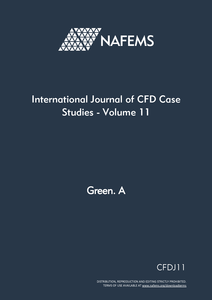 | This 11th volume of the Journal is dedicated to the memory of Gerhard Müller whose keen enthusiasm as DACH link member to the CFD editorial board is warmly remarked upon by all those who knew him. This volume offers a wide range of CFD application topics covering aerodynamics to gas release and river flow to oil-gas-particle flow, each presenting comparisons with experiment as validation. |
The prediction of the free surface flow profile of water can result in improving the design of bridge structures. In the paper by Abo et al. a CFD model is used to simulate the 3-dimensional flow through a straight, trapezoidal cross-sectional channel containing a single bridge pier. Non-dimensional curves and equations, derived from regressions of the study data, are presented as a guideline for the design of high velocity channels containing bridge piers.
Conventional Mathematical Models typically over-predict dense toxic gas plume dispersion concentrations in complex terrain. Consequently, the emergency response plans of gas-processing industries may be less effective. In the paper by Van Bavel et al. a CFD model is used to provide better understanding of dense gas plumes dispersing in a full-scale industrial setting. The authors anticipate that this evaluation may be applied to exposure characterisation and risk assessment in industries often faced with health risks to workers.
Flight test manœuvres represent a complex and challenging fluid-structure interaction involving moving aircraft surfaces. In the paper by Van Bavel et al a CFD model, using a Lattice-Boltzmann method, offers sufficient accuracy to replace some wind-tunnel testing on the Diamond D-Jet and may help to mitigate risks associated with fully developed stalls and spin flight test manœuvres.
An important element of an engine condition monitoring system is a cyclone separator used to separate and collect circulating oil debris. The paper by Kulkarni et al presents a detailed CFD model used to resolve the anisotropic structure of the turbulent flow field and multiphase interaction within a cyclone. This study uses turbulence, multiphase and drag models to establish a CFD methodology for this application of three phase separation, validated against experimental findings.
The challenge in applying CFD technology to electronics thermal design is in simulating flow and heat transfer within a complex geometries without simplification. In the paper by Mikjaniec et al a CAD-centric CFD technology is applied to an innovative honeycomb heat-sink design for a LED lighting system. A further aspect of the study was to compare experimental, CFD and CAD-centric CFD as a validation exercise.
The final paper by de Rosa et al uses computational methods applied to the design and performance of laminar wing developed within a Italian national study programme. Here stability theory is used as an approach to laminar-turbulent transition prediction in a variety of flow conditions. An Euler method is used to evaluate the basic non viscous flow followed by the application of a boundary-layer code to both compute the boundary layer and perform a linear stability analysis. Four test cases are validated against available experimental data.
Information
| Reference: | CFDJ11 |
| Author: | Green. A |
| Published: | 1st May 2016 |
| Audience: | Analyst |
| Language: | English |
| ISSN: | 1462-236X |
| ISBN: | 978-1-910643-94-5 |
| https://doi.org/10.59972/7tlrkx6h | |

Stay up to date with our technology updates, events, special offers, news, publications and training
If you want to find out more about NAFEMS and how membership can benefit your organisation, please click below.
Joining NAFEMS© NAFEMS Ltd 2025
Developed By Duo Web Design